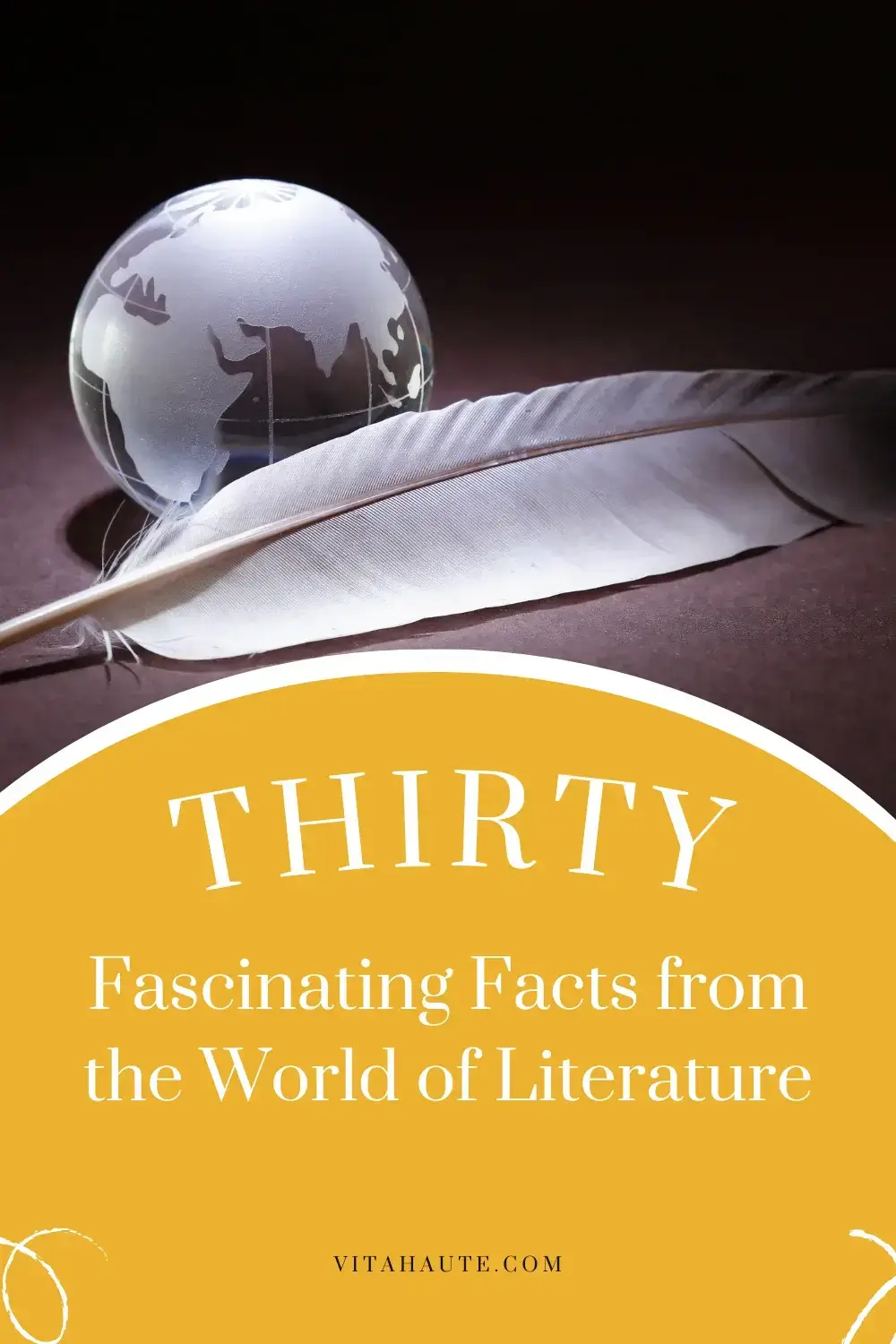As I share these 30 intriguing literary facts with you, I hope they inspire you to explore new books and authors, revisit old favorites, and appreciate the remarkable contributions of writers throughout history.

1. Joseph Conrad and Invisible Ink
Joseph Conrad wrote parts of The Secret Agent using invisible ink because he feared that his writing would be misinterpreted by the authorities. This unusual practice added a layer of intrigue to his work, emphasizing the novel’s themes of espionage and secrecy. The decision to use invisible ink resulted in a fascinating mystery surrounding the unpublished sections of his writing.
2. Harper Lee’s Forgotten Draft
Go Set a Watchman, written by Harper Lee before her iconic novel To Kill a Mockingbird, was initially considered a draft and left unpublished for decades. It was finally published in 2015, shortly before Lee’s death, sparking both interest and controversy among readers and critics. The novel offers a different perspective on the beloved characters from her earlier work, exploring themes of race, morality, and personal growth in a changing society.
3. Emily Dickinson’s Collected Poems
The Collected Poems of Emily Dickinson showcases the vast body of work produced by Emily Dickinson, who chose not to publish her poetry during her lifetime. After her death in 1886, her sister Lavinia discovered the poems and worked to bring them to light, resulting in their posthumous publication.
4. The Epic of Gilgamesh

The Epic of Gilgamesh is considered one of the oldest and most significant known surviving works of literature, dating back to around 2100 BCE. Originally passed down through oral tradition, it was eventually inscribed on clay tablets in ancient Mesopotamia. The story offers one of the earliest recorded tales of a hero’s journey, exploring themes like friendship, mortality, and the pursuit of meaning.
5. War and Peace’s Length
War and Peace by Leo Tolstoy is often cited as one of the longest novels ever published, with over 560,000 words. Its epic scope covers the Napoleonic Wars, providing intricate details about Russian society, politics, and human relationships. Tolstoy’s masterpiece is celebrated for its deep philosophical reflections and complex characterizations that capture the essence of the human experience.
6. The Tale of Peter Rabbit’s Endings
Different editions of The Tale of Peter Rabbit by Beatrix Potter have various endings. In the original, Peter is scolded by his mother for misbehaving, which adds a moral lesson to the story. However, later versions soften the ending, focusing more on Peter’s adventure and less on the consequences of his actions.
7. Guinness World Records
The Guinness World Records book itself fittingly holds the record for being the best-selling copyrighted book series of all time. Since its first publication in 1955, it has become a staple in households around the world, highlighting fascinating achievements and feats. To date, it has sold over 150 million copies, securing its place as a pop culture phenomenon.
8. The Gutenberg Bible
The Gutenberg Bible holds the record as the first major book printed using movable type. Produced by Johannes Gutenberg in the 1450s, it marked a revolutionary step in the history of book production. This technological breakthrough allowed literature to be mass-produced, leading to increased accessibility and the spread of knowledge throughout Europe.
9. Raymond Chandler’s Late Start
Raymond Chandler published his first novel, The Big Sleep, at age 51. This work marked the beginning of his influential career in the hard-boiled detective genre. Chandler went on to create memorable characters and set a standard for crime fiction that continues to resonate with readers today.
10. Miguel de Cervantes and Don Quixote
Miguel de Cervantes began writing Don Quixote while he was imprisoned for financial troubles. During his time in prison, he conceived the idea of an aging man who loses his grip on reality. This character becomes a knight-errant and embarks on wild adventures, parodying the popular chivalric romances of his time.
11. Jean-Paul Sartre’s Nobel Prize Decline
French existentialist philosopher Jean-Paul Sartre was awarded the Nobel Prize in Literature in 1964 but famously declined it. He explained that he consistently refused all official honors. Sartre believed such recognition would compromise his independence as a writer and thinker.
12. First Modern Dictionary
Samuel Johnson‘s A Dictionary of the English Language (1755) not only standardized English spelling and definitions but also included witty commentary. It remained the authoritative English dictionary for over a century until the creation of the Oxford English Dictionary.
13. Victor Hugo’s Long Journey
Les Misérables by Victor Hugo took an astounding 17 years to complete. The novel began as a project of personal passion for Hugo, who was deeply moved by the social injustices he witnessed in France. He sought to create a work that not only told an engaging story but also highlighted the harsh realities faced by the poor and marginalized members of society.
14. The Birth of James Bond
Casino Royale by Ian Fleming was the first James Bond novel, written in just over a month. Fleming wrote it while on vacation in Jamaica, driven by both inspiration and leisure. The fast writing pace helped infuse the novel with a sense of urgency and excitement, laying the foundation for the thrilling world of James Bond.
15. Truman Capote’s Writing Rituals from the Comfort of His Couch
Truman Capote famously referred to himself as a “completely horizontal author.” He preferred to write while lying in bed or on a couch rather than at a desk. This unusual habit accompanied his writing process for many of his most famous works, including Breakfast at Tiffany’s and In Cold Blood.
16. Aurum Manuscripts
In medieval Europe, certain manuscripts were written with sections in gold ink, earning them the name “Aurum Manuscripts.” These luxurious texts were typically reserved for the most sacred or important works. The use of gold symbolized both the value of the content and its divine or royal significance.
17. Isaac Asimov’s Prolific Career
Isaac Asimov was a remarkably prolific author, celebrated for his contributions to science fiction as well as popular science. Over the course of his career, he published more than 500 books, ranging from novels and short stories to essays and nonfiction works. His versatility was extraordinary; he explored topics in science, history, and even religion, making complex ideas accessible to a broad audience.
18. Evolution of Grimm’s Fairy Tales
Grimm’s Fairy Tales went through numerous editions and adaptations, with new stories added and others removed. The first edition contained 86 tales, while the seventh edition had over 200.
19. Agatha Christie’s Writing Challenges
Agatha Christie suffered from dysgraphia, a condition that made writing by hand difficult. As a result, she often dictated her novels instead of writing them. This allowed her to continue producing her famous works despite the challenge.
20. The Largest Library in the World
The Library of Congress houses over 38 million cataloged books and other print materials, making it the largest library in the world by collection size. This vast collection includes works in more than 450 languages, covering an extensive range of subjects and genres. The library continually acquires new books, ensuring that its resources reflect the evolving landscape of knowledge and culture.
21. J.D. Salinger’s Reclusive Nature
J.D. Salinger, the reclusive author of “The Catcher in the Rye,” became notorious for his aversion to public life after the immense success of his debut novel. Following the book’s release, he withdrew from the literary spotlight, choosing to live a quiet life in New Hampshire while continuing to write in solitude. Salinger published very little after the 1960s, leaving fans to speculate about the works he may have created during his decades of seclusion.
22. Cormac McCarthy’s Minimalist Style
Cormac McCarthy was known for his minimalist writing style and eschewed punctuation like quotation marks. He wrote in longhand, often using a typewriter, and avoided using a computer, which he believed distracts from the writing process.
23. Hemingway’s Standing Writing Practice
Ernest Hemingway was known for his practice of writing standing up at a typewriter. He believed this position kept him alert and helped maintain a certain physicality in his writing. He often started his day by writing early in the morning and would stop mid-sentence to keep the momentum going.
24. The First Printed Cookbook
The first known printed cookbook is De honesta voluptate et valetudine (On Honest Pleasure and Health) by Bartolomeo Platina, published in 1475. It featured recipes and advice on food and health.
25. The Longest Pulitzer Prize Winner
The longest book to receive the Pulitzer Prize for Fiction is The Executioner’s Song by Norman Mailer in 1980, at 1,056 pages.
26. Stephen King’s Debut Novel
Stephen King’s journey with his debut novel, Carrie, is a remarkable story of resilience and support. Initially, King was so dissatisfied with the manuscript that he threw it in the garbage. His wife, Tabitha, saw potential in his work and salvaged it, encouraging him to revise and finish the story. Her belief in him proved pivotal, as King reworked the manuscript, leading to its publication in 1974. “Carrie” became a groundbreaking success, launching King’s illustrious career and cementing its place in the horror genre.
27. Posthumous Sequels by Mark Twain
Tom Sawyer Abroad (1894) and Tom Sawyer, Detective (1896) are sequels published after Mark Twain’s death. In Tom Sawyer Abroad, Tom, Huck Finn, and Jim embark on an adventurous air balloon journey, exploring new lands and cultures. Meanwhile, Tom Sawyer, Detective features Tom and Huck as amateur sleuths solving a mystery involving stolen treasure. Both sequels maintain Twain’s signature humor and charm, offering readers more escapades with Tom Sawyer and his friends.
28. Cain’s Jawbone: An Interactive Puzzle
Cain’s Jawbone by Edward Powys Mathers is a fascinating and unconventional murder mystery novel, first published in 1934. This book is not only a narrative but also an interactive puzzle that engages readers in a unique way, challenging them to piece together the story from a fragmented text.
29. The Single-Sentence Novel
Solar Bones by Mike McCormack is a unique and innovative novel that stands out for its structure, as it is composed of a single sentence that spans over 200 pages. The narrative unfolds in a stream-of-consciousness style, immersing readers in the mind of the protagonist, Marcus Conway, a middle-aged engineer who reflects on his life, family, and the changes in his hometown of County Mayo, Ireland.
30. Shakespeare’s Linguistic Legacy
William Shakespeare is credited with inventing over 1,700 words, including “lonely,” “fashionable,” and “bedroom,” significantly enriching the English language.

This post contains affiliate links. Please read our disclosure.
